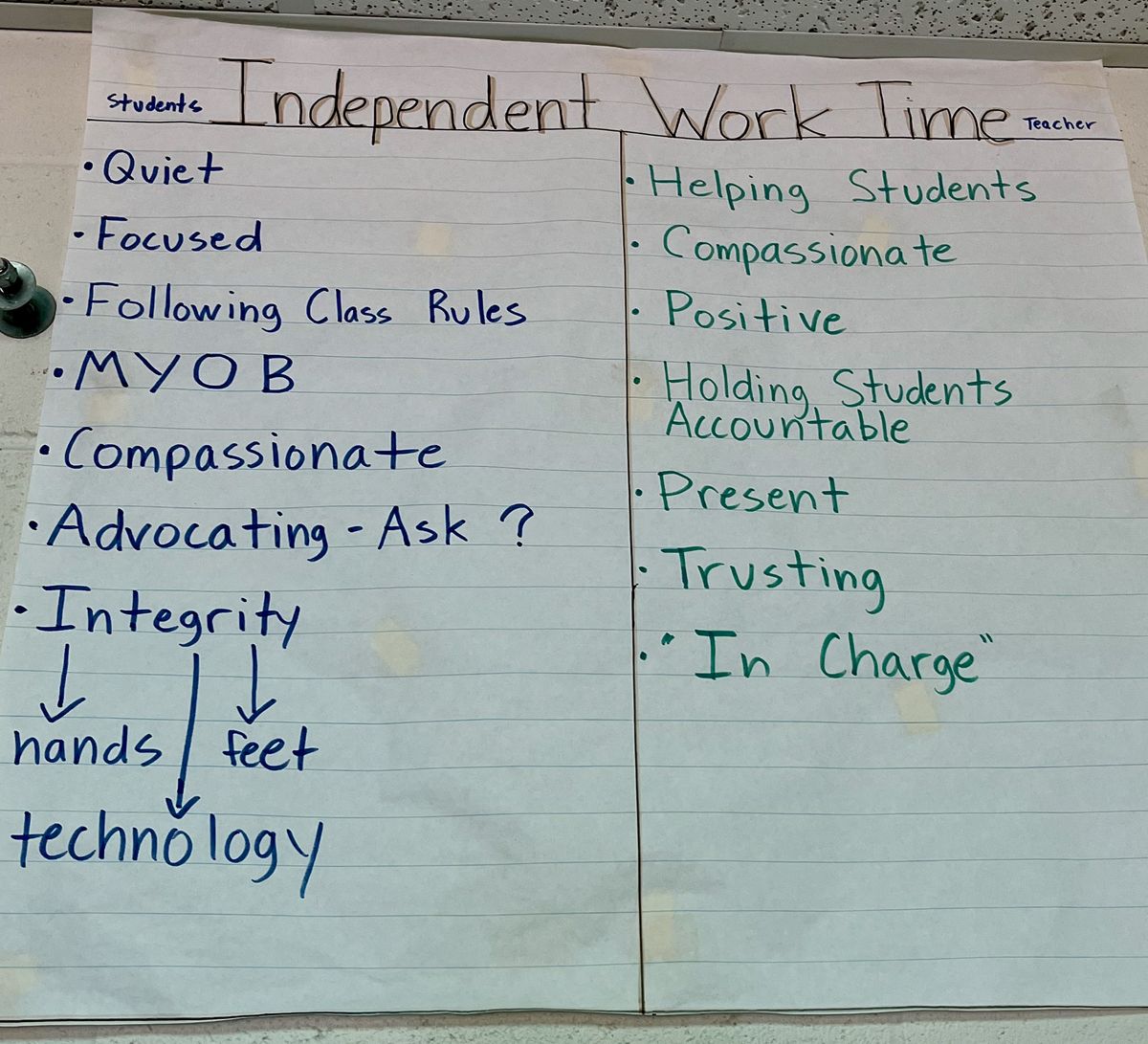Using Anchor Charts in the Classroom: Enhancing Learning, Engagement, and Student Ownership
Here’s a description of what anchor charts are, the benefits of using them, and a few ideas on how to use them in the classroom.

As an Amazon Associate, I earn from qualifying purchases. All affiliate links are marked with an asterisk (*). This helps support the newsletter. Thank You! Read more here.
Using Anchor Charts in the Classroom
Educators are always looking for effective strategies to enhance learning and engagement, and make their job easier. One tool that I have found to be incredibly helpful is the use of anchor charts. Here’s a description of what anchor charts are, the benefits of using them, and a few ideas on how to use them in the classroom.
What are Anchor Charts?
Anchor charts are visual displays that provide information and serve as a reference point for students. They are typically created collaboratively with students and displayed prominently in the classroom. These charts can cover a wide range of topics, from content-specific information to classroom expectations and routines. My favorite anchor chart is a visual reminder of the expectations for independent work for students. I use another anchor chart to outline the expectations for collaborative work.
Here a few anchor charts from my classroom.
These anchor charts have been useful to help set the tone for independent and collaborative work over the last few years. pic.twitter.com/XF2YbDyKeg
— Jeremy Jorgensen (@jeremyajorg) August 23, 2023
The Benefits of Using Anchor Charts
One of the main advantages of using anchor charts is that they provide a visual reference for students. By having important information displayed in a clear and organized manner, students can easily access and review the content whenever they need to. Anchor charts give the students an opportunity to answer questions on their own and guide their learning without asking the teacher. This is independence is good for them and for the teacher.
Anchor charts promote student engagement and participation. When students are involved in the creation process, they take ownership of the charts and feel more connected to the information presented. This active involvement encourages them to interact with the charts and actively participate in the learning process.
Another benefit of anchor charts is that they support the retention of information. Visual aids can significantly improve memory recall. By incorporating visuals, color coding, and other graphic elements, anchor charts help students remember key concepts and information more effectively. This is also one of the reasons I love interactive notebooks.
Finally, anchor charts reinforce classroom routines and expectations. By displaying classroom rules, procedures, and expectations, students have a constant reminder of what is expected of them. This visual reinforcement helps create a positive and structured learning environment.

Ideas, resources, tools, and free downloads to make your teaching life easier and more enjoyable.
Ideas for Using Anchor Charts
There are numerous ways to incorporate anchor charts in the classroom. Here are a few ideas to get you started:
Content-Specific Anchor Charts
Create anchor charts that focus on specific subjects or topics. For example, in a math class, you can have anchor charts for different math strategies or formulas. In a science class, you can have anchor charts that explain scientific processes or highlight important vocabulary.
Interactive Anchor Charts
Make your anchor charts interactive by using sticky notes, movable pieces, or other interactive elements. This allows students to actively engage with the charts and add their own thoughts, questions, or examples.
Process Charts
Use anchor charts to guide students through step-by-step processes. This can be particularly helpful in subjects like writing or problem-solving, where students can refer to the chart as a visual aid to help them navigate the process.
Vocabulary and Word Walls
Create anchor charts that focus on vocabulary words or word walls. This helps students expand their vocabulary and serves as a visual reminder of important terms.
Classroom Rules and Expectations
Display anchor charts that outline classroom rules, procedures, and expectations. This helps students understand and remember the expectations set forth in the classroom, promoting a positive and respectful learning environment.
Tips for Creating Effective Anchor Charts
To ensure that your anchor charts are effective, consider the following tips:
- Use clear and concise language: Keep the information on the charts simple and easy to understand.
- Incorporate visuals and color: Visual elements make the charts more appealing and help with information retention.
- Involve students in the creation process: Encourage students to contribute ideas, drawings, or examples to make the charts more interactive and meaningful.
- Keep anchor charts visible and accessible: Display the charts in a prominent place where students can easily refer to them throughout the day.
Anchor Charts - Links and Resources
- Ready Made Anchor Charts*
- Anchor Chart Paper* (blank page) - These sticky pads cost money, but they are worth.
- Anchor Chart Paper* (lined page) - Same type of sticky pad as above but with lines (with my handwriting the lines are needed).
- Why Anchor Charts Are Important
- Creating Effective Anchor Charts in Your Mini-Lessons
- Anchor Charts: What Are They and How Can Teachers Use Them in the Classroom
- Initiate and Innovate Anchor Charts - This is an extensive resource.
- 30 Awesome Anchor Charts to Spice Up Your Classroom - some great examples
- Make the Most of Your Classroom Walls
Anchor Chart Examples
Anchor charts can be so useful. 🤩
— edutopia (@edutopia) October 3, 2023
Here's a look at 3 from @guided4math on Instagram. pic.twitter.com/bv9jRjm59d
Introducing Math anchor chart pulley system🔗⚙️Students know where to look to find support and practice agency while experimenting STEM problem solving tools! 🦅@DanDRogersDISD @dallasschools pic.twitter.com/0oFFm5nyDA
— Maria Miret Bofi (@mariamiret4) October 5, 2023
Our amazing paraprofessional was so excited about her 1st anchor charts! I am glad that she chose to share them with me! I want her to have this photo to look back on when she starts teaching, which is not too far away.#GoalSetting #creatingteachers #persistence #empoweringothers pic.twitter.com/edbxWo6HAt
— Dr. D.L. Haddock (@PrincipalDrH) October 3, 2023
Anchor charts can be powerful tools! Ms. Short’s class used this one while reading Wolfie the Bunny! 🐰 #risdweareone #risdbelieves #risdk2creates @BSE_Bobcats1 pic.twitter.com/1NemdzMTpF
— Laura Moore (@mooretolearn) October 5, 2023
Anchor chart for What is stress? This helps us talk through common stressors, body changes with stress, and ways to cope from stressors. #anchorcharthealth pic.twitter.com/jLhTsIzDx0
— Mrs. Hobbs (@MrsHobbsPE) September 28, 2023
Check out the co- created anchor chart @RiveraElem 😍 pic.twitter.com/XseiubXdh9
— Tosha Hoefert (@MathFanHoefert) October 3, 2023
Let there be anchor charts!! pic.twitter.com/mtefwvXh8v
— Allyson Kiernan (@MsKiernanReads) October 4, 2023
❤ Enjoy this Newsletter?
🍵 Show Your Support, 🛍 Shop The Store, 👕 Buy Some Swag, 🤗 Share It




